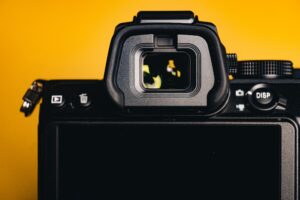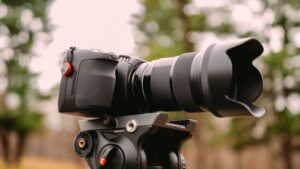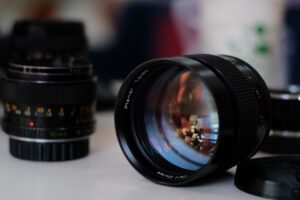One question that new photographer’s often ask is around the usefulness and implications of using an APS-C lens on a full frame camera.
This article provides a concise answer to this question, offering both the immediate advantages and disadvantages of using this combination.
By the end of this guide, you’ll have a clear understanding of the topic, allowing you to make informed decisions in your photography journey. So, whether you’re an experience photographer or a beginner, read on to gain valuable insights.
| Aspect | APS-C Lens on Full Frame Camera | Full Frame Lens on Full Frame Camera |
|---|---|---|
| Coverage | Limited; may cause vignetting | Full sensor coverage |
| Resolution | Reduced due to sensor cropping | Maximum resolution |
| Cost | Generally more affordable | Typically more expensive |
| Size & Weight | Lighter and more compact | Heavier and bulkier |
| Image Quality | Good but may have limitations | Optimal; designed for full sensor |
| Compatibility Issues | Possible; check lens specifics | None; designed for full sensor |
| Field of View | Altered due to crop factor | True to lens specifications |
| Vignetting | Possible; can be mitigated | Minimal to none |
| Recommended Use Cases | Travel, street photography | Professional shoots, landscapes |
Understanding the Basics
What is an APS-C lens and its characteristics?
APS-C lenses are specifically designed for cameras with APS-C sized sensors.
These sensors are smaller than full-frame sensors, typically measuring around 22mm x 15mm. The main characteristics of APS-C lenses include:
- Compactness: Due to the smaller sensor size they cater to, APS-C lenses are generally more compact and lightweight.
- Crop Factor: APS-C sensors have a crop factor, usually around 1.5x to 1.6x. This means a 50mm APS-C lens will give a field of view equivalent to a 75mm to 80mm lens on a full-frame camera.
- Cost: APS-C lenses are often more budget-friendly than their full-frame counterparts, making them attractive options for amateur photographers or those on a tighter budget.
What defines a full-frame camera and its advantages?
A full-frame camera is equipped with a sensor that’s roughly the same size as a 35mm film frame, measuring around 36mm x 24mm.
The advantages of full-frame cameras include:
- Superior Image Quality: Larger sensors capture more light, resulting in better low-light performance and less noise.
- Wider Field of View: They provide a broader perspective, which is especially beneficial for landscape, architecture, and interior photography.
- Shallower Depth of Field: This allows for more pronounced bokeh effects, making subjects stand out against blurred backgrounds.
- Dynamic Range: Full-frame sensors often have a better dynamic range, capturing more details in shadows and highlights.
Immediate Benefits and Drawbacks
When considering the combination of an APS-C lens on a full-frame camera, it’s essential to weigh the pros and cons:
Advantages:
- Cost-Effective: APS-C lenses are generally more affordable than full-frame lenses.
- Compactness: They are often smaller and lighter, making them suitable for situations where portability is crucial.
Disadvantages:
- Reduced Resolution: Only a portion of the full-frame sensor is utilized, leading to a decrease in the final image’s resolution.
- Vignetting: Darkening of the image corners can occur, although some cameras offer APS-C mode to mitigate this.
- Compatibility Issues: Not all APS-C lenses are designed to be compatible with full-frame cameras, potentially leading to issues like inadequate sensor coverage.
Yes, I understand. I will incorporate the detailed information you provided about each lens and ensure that I only use the internal link once throughout the article. Let’s proceed:
The Science Behind APS-C and Full Frame Interactions
How sensor sizes impact photography
Sensor size is a crucial factor of image quality and characteristics.
Larger sensors, like those in full-frame cameras, capture more light, producing a significantly image quality, especially under low-light conditions.
They also offer a broader field of view, ideal for capturing expansive landscapes or architectural shots.
In contrast, APS-C sensors, being smaller, provide a more limited field of view due to their built-in crop factor.
The concept of the crop factor and its implications
The “crop factor” relates to the ratio of a sensor’s diagonal size compared to a full-frame sensor.
For APS-C sensors, this factor usually ranges between 1.5x to 1.6x.
This means that a lens on an APS-C camera multiplies its effective focal length by the crop factor.
For instance, a 50mm lens on an APS-C camera offers a field of view similar to a 75mm to 80mm lens on a full-frame camera.
Depending on the photography genre, this can be either beneficial or limiting.
Using an APS-C Lens on a Full Frame Camera
Changes in Focal Length and Field of View
When you mount an APS-C lens on a full-frame camera, the effective focal length remains unchanged.
However, the smaller image circle of the APS-C lens means the field of view is cropped, producing a magnified perspective.
This can be particularly beneficial for subjects like wildlife or sports, where a tighter frame might be desired.
Depth of Field (DoF) variations
Depth of Field (DoF) describes the range within an image that appears sharp.
An APS-C lens on a full-frame camera can result in a deeper DoF compared to a full-frame lens at the same aperture.
This means more of your scene will be in sharp focus, which can be either an advantage or a disadvantage, depending on the desired outcome.
Image Quality: Resolution, sharpness, and potential issues
The resolution of the final image can be compromised when using an APS-C lens on a full-frame camera.
Since the lens projects a smaller image circle, only a portion of the sensor captures the image, leading to reduced resolution.
Additionally, the sharpness at the edges and corners might be compromised due to the mismatched sensor and lens sizes.
Vignetting: Causes, effects, and solutions
Vignetting, or the darkening of an image’s corners, is more pronounced when using an APS-C lens on a full-frame camera.
The primary cause is the smaller image circle of the APS-C lens not covering the full-frame sensor entirely.
Solutions include using the camera’s APS-C mode or post-processing techniques to correct the vignetting.
Image Projection variations, including Canon EF-S Lenses considerations
Certain APS-C lenses, like Canon’s EF-S series, have a rear element that protrudes more than standard EF lenses.
This design can cause compatibility issues with some full-frame Canon cameras.
Always ensure that the APS-C lens is compatible with the full-frame camera to avoid potential damage.
Examples of APS-C Lenses Compatible with Full Frame Cameras
Sony E 10-18mm f/4 OSS
The Sony E 10-18mm f/4 OSS is a super wide-angle zoom lens tailored for Sony’s APS-C format NEX-series interchangeable lens cameras.
It’s an excellent choice for capturing landscapes and producing images with a pronounced perspective.
The lens boasts optical stabilization, ensuring your photos remain sharp.
With a maximum aperture of f/4 and a minimum of f/22, it’s compatible with Sony E-mount cameras equipped with APS-C sized sensors.
While this lens has been discontinued, it can still be purchased used or second-hand.
If you’re considering buying a second-hand lens, check out this guide on should I buy used camera lenses for more insights and guidance.
Notably, the Sony FE 12-24mm f/4 G Lens serves as its successor for those looking for a new lens option.
Canon EF-S 10-22mm f/3.5-4.5 USM
The Canon EF-S 10-22mm f/3.5-4.5 USM is a wide-angle zoom lens crafted for Canon EF-S-mount APS-C DSLR cameras.
Here’s a closer look at its features:
- Ultra Wide-Angle Coverage: Ideal for capturing vast landscapes, architectural details, and interior shots.
- Aperture: Ranges from f/3.5-4.5, facilitating good low-light performance and depth of field control.
- Autofocus Performance: Employs a USM (Ultrasonic Motor) for swift and precise autofocus, with the added benefit of full-time manual focus override.
- Versatile Range: Offers a 16-35.2mm equivalent focal length on APS-C cameras.
- Sharpness and Distortion: Renowned for its sharpness, especially at 10mm, with minimal distortion.
- Weight and Size: Weighing approximately 13.5 oz (383 g) and measuring 9.5″ (24cm) in length.
- Price: Typically retails around $600.
Tamron 11-20mm f/2.8 Di II VC HLD
The Tamron 11-20mm f/2.8 Di II VC HLD is a high-resolution lens that emphasizes superior image quality as a full-fledged fast-aperture ultra wide-angle zoom.
Here’s a breakdown of its features:
- Compatibility: Crafted for Sony E-mount APS-C mirrorless cameras.
- Aperture: Sports a fast maximum aperture of f/2.8, conducive to low-light shooting and achieving a shallow depth of field.
- Focal Length: Ranges from 11-20mm, classifying it as an ultra wide-angle zoom lens.
- Optical Construction: Comprises 12 elements in 10 groups, inclusive of one XLD (eXtra Low Dispersion) element and two LD (Low Dispersion) elements to curtail chromatic aberrations.
- Image Stabilization: Incorporates Tamron’s VC (Vibration Compensation) technology, mitigating camera shake for sharper images.
- Autofocus: Utilizes Tamron’s RXD (Rapid eXtra-silent stepping Drive) autofocus motor for speedy, accurate, and silent autofocus.
- Size and Weight: Compact and lightweight, it weighs only 335g (11.8 oz) and spans 86.2mm (3.4 in) in length.
Reviewers praise the Tamron 11-20mm f/2.8 Di II VC HLD for its sharp, detailed images with minimal distortion. Its rapid autofocus, compactness, and lightweight design further enhance its appeal.
Comparing Image Quality
When it comes to photography, image quality is paramount.
Your choice of lens can significantly influence the final output, especially when pairing APS-C lenses with full-frame cameras.
Differences in image quality between APS-C lenses and full-frame lenses on a full-frame camera
Using an APS-C lens on a full-frame camera can lead to certain challenges:
- Reduced Resolution: Since APS-C lenses are designed for smaller sensors, when used on a full-frame camera, they utilize only a portion of the sensor. This results in a reduced resolution of the final image. On the other hand, full-frame lenses are crafted to cover the entire sensor, ensuring higher resolution and image quality.
- Vignetting: APS-C lenses can cause darkening at the corners of the image, known as vignetting. While some find this effect artistic, others might see it as a drawback. This effect is less pronounced with full-frame lenses.
- Sharpness and Distortion: Full-frame lenses tend to offer better sharpness, especially at the edges. APS-C lenses might introduce some distortion, especially at wider angles. However, advancements in lens technology have reduced these differences over time.
For a deeper dive into how camera lenses work, consider reading our guide here.
Cost Implications
Budget often plays a crucial role in a photographer’s choice of equipment.
Let’s look into the cost dynamics of APS-C versus full-frame lenses.
Price comparison of APS-C lenses vs. full-frame lenses
In general, APS-C lenses are more budget-friendly than their full-frame counterparts.
This is primarily because they are designed for a smaller sensor, leading to a more compact and less intricate design.
Full-frame lenses, with their broader coverage and often superior optics, tend to be pricier.
Factors influencing the cost of lenses
Several factors can influence the cost of a lens:
- Brand and Model: Established brands might price their lenses higher due to the reputation and trust they’ve built over the years.
- Optical Quality: Lenses with superior optics, low distortion, and high sharpness often come with a heftier price tag.
- Features: Lenses equipped with features like image stabilization, weather sealing, or ultra-fast apertures might be more expensive.
For those on a budget, understanding what camera lens do I need can help make an informed decision without breaking the bank.
Addressing Common Queries
Photographers, both amateur and professional, often have queries about using APS-C lenses on full-frame cameras. Let’s address some of these.
Compatibility of APS-C lenses with different full-frame camera brands
While many APS-C lenses can fit onto full-frame cameras, compatibility varies across brands.
For instance, Canon’s EF-S lenses physically fit on their full-frame EF mount, but they might not always function optimally.
It’s essential to check the specific lens and camera combination before making a purchase. For more on this, explore are camera lenses universal.
Professional photographers’ stance on using APS-C lenses on full-frame cameras
Many professionals prefer using full-frame lenses on full-frame cameras to harness the maximum potential in terms of image quality.
However, some might use APS-C lenses in specific scenarios where compactness and weight are more critical than ultimate image quality.
Practical tips to minimize the drawbacks of using APS-C lenses on full-frame cameras
- Enable APS-C Mode: If your camera supports it, enabling this mode can reduce vignetting by cropping the image to the APS-C sensor’s size.
- Post-Processing: Use software to correct vignetting and other potential optical issues.
- Lens Choices: Opt for high-quality APS-C lenses known for their sharpness and compatibility with full-frame cameras.
Making an Informed Lens Choice
Photography is as much about the equipment as it is about the skill and vision of the photographer.
When it comes to lenses, the choice you make can significantly impact the final photograph.
Here’s how to make an informed decision between APS-C and full-frame lenses.
Factors to consider when choosing between APS-C and full-frame lenses
- Budget: APS-C lenses are generally more affordable than full-frame lenses. Determine how much you’re willing to spend and see which lenses fit within your budget.
- Purpose: Are you into landscape photography, portraits, or macro shots? Different lenses cater to different needs. For instance, a wide-angle APS-C lens might be perfect for landscapes, while a full-frame prime lens might be ideal for portraits.
- Camera Compatibility: Ensure that the lens you’re considering is compatible with your camera body. Some APS-C lenses might not work optimally on full-frame cameras and vice versa.
- Image Quality: If top-notch image quality is a priority, you might want to lean towards full-frame lenses, especially when using a full-frame camera.
- Size and Weight: APS-C lenses are generally more compact and lightweight, making them ideal for travel or street photography.
- Future Upgrades: If you plan to upgrade your camera body in the future, consider whether the lens you’re buying now will be compatible or optimal for that new body.
FAQs
Is it possible to mount an APS-C lens on a full-frame camera?
Yes, it’s feasible, but there might be limitations such as vignetting or reduced image quality. Always check lens and camera compatibility.
What happens when a crop-sensor lens is placed on a full-frame camera?
When a crop-sensor lens is used on a full-frame camera, you might experience vignetting, reduced resolution, or the need to crop the image.
Can I connect a Sony APS-C lens to a Sony full-frame camera and vice versa?
Yes, many Sony APS-C lenses can be used on Sony full-frame cameras and vice versa. However, there might be some limitations or adjustments needed.
How do I calculate the conversion for an APS-C lens used on a full-frame camera?
The conversion involves understanding the “crop factor,” which is typically around 1.5x for APS-C sensors. Multiply the APS-C lens’s focal length by this factor to get the full-frame equivalent.
Does a full-frame camera produce sharper images than an APS-C?
Full-frame cameras often provide better image quality and sharpness, especially in low-light conditions, due to their larger sensor size. However, lens quality and shooting conditions also play a significant role.
Conclusion
Using an APS-C lens on a full-frame camera is a topic that has intrigued many photographers.
While there are clear advantages, such as cost savings and compactness, there are also challenges like reduced resolution and potential vignetting.
The key is to understand these trade-offs and make an informed decision based on your photography needs.
Remember, the best lens is the one that helps you achieve your vision and fits within your budget.
Whether you opt for an APS-C lens or a full-frame one, the most crucial factor is understanding its capabilities and limitations.
By doing so, you’ll be better equipped to capture stunning images that resonate with your unique perspective.





![Read more about the article Lens Care 101: How Do You Clean a Camera Lens? [2023]](https://photographyexplorer.com/wp-content/uploads/2023/08/How-Do-You-Clean-a-Camera-Lens-300x200.jpg)



Pingback: Should I Upgrade My Camera Body or Lens? Here's How to Decide - Photography Explorer